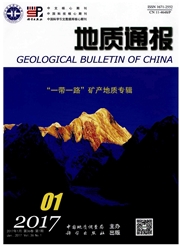

 中文摘要:
中文摘要:
贵州金沙长岩沟牛蹄塘组生物群化石丰富,共计25属,以海绵动物为主,另有节肢动物及藻类两大门类化石代表。海绵动物以普通海绵为主,计8属,占整个海绵动物属的57%;六射海绵5属,占海绵的36%,另有纲、目及科未定1属。节肢动物8属中高肌虫占优势,计有5属;大型双壳节肢动物2属,三叶虫仅1属。藻类共计3属。与遵义牛蹄塘生物群相比,两地均以普通海绵为主.金沙长岩沟牛蹄塘生物群海绵更为丰富,与遵义黑沙坡的海绵组成有差异。金沙长岩沟节肢动物中三叶虫少,仅1属,但高肌虫丰富,达5属,而遵义黑沙坡只有2属高肌虫,三叶虫则达4属。遵义和金沙牛蹄塘组生物群分别有藻类属4个和3个.共有属2个。两地同一生物群组成的差异,说明同处扬子浅水区的金沙长岩沟及遵义黑沙坡沉积环境可能有所差异,因而组成面貌也有差异,两地牛蹄塘生物群均具有显著的澄江生物群色彩。
 英文摘要:
英文摘要:
The Niutitang Biota in Changyangou Village, Jinsha County, just as in Heishapo Village, Zunyi County where the biota was named, has abundant fossils which include 25 genera, belonging to Sponges, Arthropoda and Algae. Among Sponges, the Demo- spongea has 8 genera which are Leptomitus, Leptomitella,Paraleptomitella, Tokakkawia, Crumillospongia, Choia, ChoiaeUa and Allan- tospongia, accounting for 57% of Sponges; the Hexactinellida has 5 genera which are Kunmingella, Emeiella, Hanchiangella, Tsun- yiella and Songlinella, accounting for 36%; the genus Solactiniella Mehl and Reitner, 1993 is gen. et sp. indet. There are 8 genera in Arthropoda, dominated by Bradoriida with 5 genera which are Kunmingella, Emeiella, Hanchiangella, Tsunyiella and Songlinella; 2 genera of large bivalved arthropod animals are lsoxys and Perspicaris; 1 genus of Trilobita is Tsunyidiscus, the most important trilobite of Niutitang Formation. Three genera of Algae are Zunyiphyton, Sinocylimtra and Verdotaenia. In contrast with Heishapo Niutitang Biota in Zunyi, sponges in Zhangyangou Niutitang Biota in Jinsha are more abundant, dominated by Demospongea. The two biotas are not identical with Jinsha having 2 genus of trilobites and 5 genera of Bradoriida while Zunyi having 4 genera of trilobites and 2 genera of Bradorrida. Zunyi and Jinsha have 4 genera and 3 genera of algaes respectively and share 2 genera. Though both Jinsha and Zunyi located in the shallow water of Yangtze Platform, the difference between the two biotas implies the nonidentity of the sedimen- tary environment in the two places. Both of the two biotas possess the earmarks of the Chengjiang Biota.
 同期刊论文项目
同期刊论文项目
 同项目期刊论文
同项目期刊论文
 期刊信息
期刊信息
